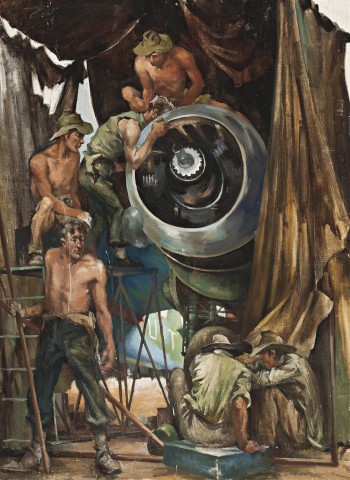MAINTENANCE WORK ON A BEAUFIGHTER, 1945
HAROLD FREEDMAN
oil on canvas on composition board
104.0 x 76.5 cm
bears inscription on old label verso: Maintenance Work on a Beaufighter / F/LH. Freedman / February 1945
Officers’ Mess clearance sale, RAAF Frognall, Melbourne
Squadron Leader Ray Cowburn, acquired from the above c.1965
Thence by descent
Private collection, New South Wales
Maintenance, 1945, watercolour on paper, 30.5 x 43.8 cm, in the collection of the Australian War Memorial, Melbourne
Harold Freedman was a Victorian freelance artist who trained under renowned muralist Napier Waller, and was subsequently responsible for many of Melbourne’s public artworks such as the spectacular mosaic Legend of Fire (Eastern Hill Fire Brigade, Melbourne) and in Canberra, a large mural depicting the history of Australian military aviation for the Australian War Memorial (AWM). However, during World War II he was a war artist attached to the RAAF War History Section, and Maintenance Work on a Beaufighter, 1945, is a fine example of his work from that period. It is also a companion to the numerous Freedman paintings held by the AWM and the State Library of Victoria.1 Once appointed, Freedman was given the honorary rank of Flight-Lieutenant2 and ‘in December 1944 … travelled to New Guinea. By February 1945, he was attached to the RAAF’s 1st Tactical Air Force, with its headquarters at Noemfoor Island.’3 Freedman demonstrated a particular empathy with the troops and many of his detailed images focus on radio operators, the telephone exchange, pilots exchanging yarns in tents, and aeroplanes under repair.
Maintenance Work on a Beaufighter depicts a scene on Noemfoor Island, which had become a key location for the maintenance and repair of Allied aircraft following fierce fighting in July and August 1944. Given the island was almost directly on the Equator, it is not surprising that the mechanics are shown in various states of undress. The extreme weather conditions also made it necessary for aircraft under repair to be protected at all times and, as the painting so vividly illustrates, temporary work shelters were constructed from any scrounged material found at the base.4 Alongside the Kittyhawk and the B-24 Liberator bomber, the Beaufighter was one of the RAAF’s key weapons, a powerful killing machine memorably described by pilots as being ‘two engines closely followed by an airplane.’ The Japanese however called it the ‘Whispering Death’ such was its devastating firepower. In Servicing a Beaufighter Aircraft, two teams focus on the repairs, whilst their standing companion is a ‘type’ rather than a direct portrait, reminiscent of the larrikin soldier memorably depicted on screen during the war by Australian actor Chips Rafferty.
In 1946, an exhibition of the RAAF paintings executed by Freedman, Eric Thake and Max Newton toured all major State capitals with the catalogue’s lead image being Freedman’s Fighter Pilot. Of the forty-two works shown by the artist, thirty were oils, many of which were completed following his return to Australia. Also included was a watercolour entitled Maintenance dated February 1945, which is the source for the painting on offer here. It depicts the identical scene of aeroplane and makeshift hanger but does not include the six mechanics who appear in the final oil composition.5 At the conclusion of World War II, Freedman’s war paintings were distributed between RAAF bases and the Australian War Memorial with Maintenance Work on a Beaufighter finding a home at RAAF Frognall, an Italianate 1880s mansion in Canterbury, Victoria, which eventually closed in 1984, selling off its collection of artwork and general paraphernalia in the process. Purchased from these sales by the then-Commanding Officer, this painting has remained in the same family’s collection ever since.
1. Freedman also painted the Cavalcade of Transport mural for the concourse at the Spencer Street (now Southern Cross) railway station in Melbourne.
2. One of Freedman’s artist companions during this period was (Flying Officer) Eric Thake.
3. Baddeley, C., ‘Harold Freedman (1915-1999)’, in Wilkins, L. (ed.), Artists in Action: from the collection of the Australian War Memorial, Thames and Hudson, Melbourne, 2003, p. 92. Noemfoor Island is near the northern tip of West Papua.
4. See RAAF war paintings, exhibition catalogue, National Gallery of Victoria, Melbourne (and touring State capitals), 1946 (text under cat.7).
5. Collection: Australian War Memorial, Canberra.
ANDREW GAYNOR
